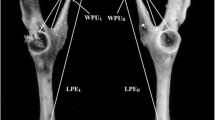Abstract
This study examines the relationship between public symphyseal synostosis and sexual dimorphism of the pelvis in two sympatric species ofPresbytis—P. cristata andP. rubicunda. Whereas no specimen ofP. cristata shows fusion of the interpubic joint, a high percentage of female (43.8%) and male (83.3%)P. rubicunda have a fused public symphysis. As females of both species are similar in body size, they are predicted to give birth to similarly sized newborns. Based on comparison with other anthropoids, the percentage dimorphism in the ischiopubic index inP. cristata andP. rubicuda suggests selection on pelvic capacity in relation to obstetrics. In species characterized by cephalopelvic constriction (i.e., the size of the fetal cranium closely approximates the capacity of the maternal birth canal), successful birth seems possible only by a hormonally induced increase in pelvic joint mobility during delivery. However, fusion of the interpubic joint obviates pelvic joint mobility. Consequently, this study tests the hypothesis thatP. rubicunda shows obstetric adaptations of the pelvis that are not found inP. cristata. The results show that pelvic capacity is larger in females than males in bothP. cristata andP. rubicunda; the sexual difference is most pronounced at the inlet. Moreover, the pattern of pelvic dimorphism is nearly identical between the species. When females of the two species are compared,P. rubicunda evidences a shorter distance between the sacroiliac and hip joints and a wider bituberous diameter. The former is related to interspecific differences in locomotion, and the latter is associated with obstetrics.
Similar content being viewed by others
References
Bernstein, I. S. (1968). The lutong of Kuala Selangor.Behaviour 32: 1–16.
Crelin, E. S. (1969). The development of the bony pelvis and its changes during pregnancy and parturition.Trans. N.Y. Acad. Sci. 31: 1049–1058.
Davies, A. G. (1984).An Ecological Study of the Red Leaf Monkey (Presbytis rubicunda) in the Dipterocarp Forest of Northern Borneo, Ph.D. dissertation, University of Cambridge, Cambridge.
Fleagle, J. G. (1976). Locomotor behavior and skeletal anatomy of sympatric Malaysian leaf-monkeys (Presbytis obscura andPresbytis melalophos).Yrbk. Phys. Anthropol. 20: 440–453.
Fleagle, J. G. (1977). Locomotor behavior and muscular anatomy of sympatric Malaysian leaf-monkeys (Presbytis obscura andPresbytis melalophos).Am. J. Phys. Anthropol. 46: 297–308.
Fleagle, J. G. (1978). Locomotion, posture, and habitat utilization in two sympatric, Malaysian leaf-monkeys (Presbytis obscura andPresbytis melalophos). In Montgometry, G. G. (ed.),The Ecology of Arboreal Folivores, Smithsonian Institution Press, Washington, DC, pp. 243–251.
Fleagle, J. G. (1988).Primate Adaptation and Evolution, Academic Press, San Diego, CA.
Furuya, Y. (1961–1962). The social life of silvered leaf monkeys,Trachypithecus cristatus.Primates 3: 41–60.
Gardner, W. U. (1936). Sexual dimorphism of the pelvis of the mouse: The effect of estrogenic hormones upon the pelvis and upon the development of scrotal hernias.Am. J. Anat. 59: 459–483.
Gardner, W. U., and Van Heuverswyn, J. (1940). Inhibition of pelvic changes occurring during pregnancy in mice by testosterone propionate.Endocrinology 26: 833–836.
Hall, K. (1950). The effect of oestrone and progresterone on the histological structure of the symphysis pubis of the castrated female mouse.J. Endocrinol. 7: 54–63.
Hall, K. (1951). The effect of hysterectomy on the action of oestrone on the symphysis pubis of ovariectomized mice.J. Endocrinol. 7: 299–306.
Hartman, C. G., and Straus, W. L. Jr. (1939). Relaxation of the pelvic ligaments in pregnant monkeys.Am. J. Obstet. Gynecol. 37: 498–500.
Johnson, M. H., and Everitt, B. J. (1988).Essential Reproduction, Blackwell Scientific Publication, Boston.
Leutenegger, W. (1974). Functional aspects of pelvic morphology in simian primates.J. Hum. Evol. 3: 207–222.
Leutenegger, W. (1982). Encephalization and obstetrics in primates with particular reference to human evolution. In Armstrong, E., and Falk, D. (eds.),Primate Brain Evolution: Methods and Concepts, Plenum Press, New York, pp. 85–95.
Napier, J. R., and Napier, P. H. (1985).The Natural History of the Primates, British Museum (Natural History), London.
Pocock, R. I. (1925). The external characters of the catarrhine monkeys and apes.Proc. Zool. Soc. Lond., pp. 1479–1579.
Schultz, A. H. (1944). Age changes and varaibility in gibbons.Am. J. Phys. Anthropol. 2 (n.s.): 1–129.
Steudel, K. (1981). Functional aspects of primate pelvic structure: A multivariate approach.Am. J. Phys. Anthropol. 55: 399–410.
Steudel, K. (1984). Patterns of allometry in the pelvis of higher primates.J. Hum. Evol. 13: 545–554.
Storey, E. (1957). Relaxation in the pubic symphysis of the mouse during pregnancy and after relaxin administration, with special reference to the behaviour of collagen.J. Pathol. Bacteriol. 74: 147–162.
Stott, K., Jr., and Selsor, C. J. (1961). Observations of the maroon leaf monkey in North Borneo.Mammalia 25: 184–189.
Straus, W. L. Jr. (1929). Studies on primate ilia.Am. J. Anat. 43: 403–460.
Tague, R. G. (1988). Bone resorption of the pubis and preauricular area in humans and nonhuman mammals.Am. J. Phys. Anthropol. 76: 251–267.
Tague, R. G. (1990). Morphology of the pubis and preauricular area in relation to parity and age at death inMacaca mulatta.Am. J. Phys. Anthropol. 82: 517–525.
Talmage, R. V. (1947). Changes produced in the symphysis public of the guinea pig by the sex steroids and relaxin.Anat. Rec. 99: 91–114.
Teaford, M. F. (1983). Differences in molar wear gradient between adult macaques and langurs.Int. J. Primatol. 4: 427–444.
Todd, T. W. (1921). Age changes in the pubic bone. V. Mammalian pubic metamorphosis.Am. J. Phys. Anthropol. 4: 333–406.
Washburn, S. L. (1942). Skeletal proportions of adult langurs and macaques.Hum. Biol. 14: 444–472.
Washburn, S. L. (1943). The sequence of epiphyseal union in Old World monkeys.Am. J. Anat. 72: 339–360.
Wolf, K. (1984).Reproductive Competition Among Co-Resident Male Silvered Leaf-Monkeys (Presbytis cristata), Ph.D. dissertation, Yale University, New Haven, CT.
Author information
Authors and Affiliations
Rights and permissions
About this article
Cite this article
Tague, R.G. Pubic symphyseal synostosis and sexual dimorphism of the pelvis inPresbytis cristata andPresbytis rubicunda . International Journal of Primatology 14, 637–654 (1993). https://doi.org/10.1007/BF02215452
Received:
Revised:
Issue Date:
DOI: https://doi.org/10.1007/BF02215452




